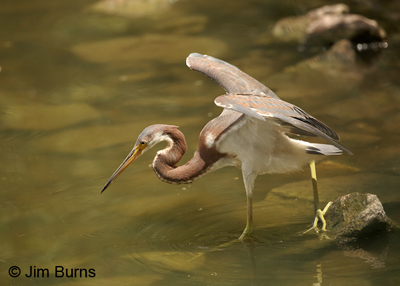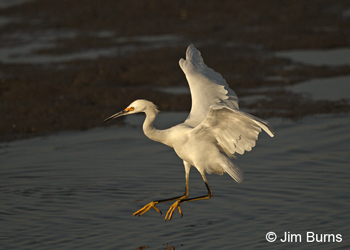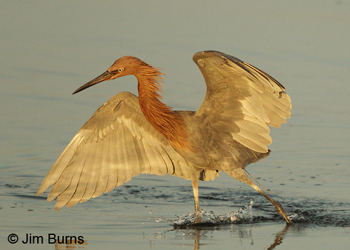
You could carry an umbrella at all times. Sounds a little over the top? Pun intended, but there’s a family of birds that does this very thing, the Egretta herons. Their “umbrella” is their wings, they stretch them out over their head and upper body while fishing in shallow water, particularly on sunny days, and this behavioral feeding technique is called Canopy Feeding, not to be confused with the same term used for small passerines flocking through the uppermost foliage in the rain forests.
Canopy Feeding is most highly developed in the Black Heron of Africa, but three of North America’s four Egretta species, Reddish Egret, Tricolored Heron, and Snowy Egret are known to employ it, Reddish Egret being the most frequent and notorious user. Reminded of this when I photographed the juvenile Tricolored at Gilbert Water Ranch doing it, I did a little research and discovered there are two explanations for this efficacious feeding behavior: the most logical one to cell phone users is that glare off the water obscures the prey species below the surface; a second and equally sound one is that small prey fish are attracted to shade, especially on hot sunny days. The heron’s wing umbrella not only helps it see the prey, but provides a patch of shade which attracts the prey to it. Doubly efficacious.
Just as experienced birders and bird photographers learn to watch for patterns of behavior, so too must all wildlife species because their very survival depends upon it. No surprise that some herons have learned to use wings as well as beaks and claws as tools, and it would seem that if a juvenile of a species utilizes Canopy Feeding, then Canopy Feeding must be evolutionarily inculcated into that species. Hard wired.
I watched the young Trike feed down the side of the pond, ever so slowly, using a technique actually known to researchers as Walking Slowly, which is exactly what the term implies. And it is very slowly. One step, pause and wait. As compared to the Green Heron sharing the small pond and utilizing Stand and Wait. The Trike would often take one step out from the bank, still in the shade of the reeds and grass, crouch so low its belly was on the water, then make horizontal stabs forward with the rapier bill. Only when it reached an inflow where the bank became unvegetated and the shore unshaded did it begin Canopy Feeding and stabbing downward for the capture.
The Tricolored Heron in Gilbert was a passing vagrant, a species only seen in Arizona during post-breeding dispersal in late summer, and not seen every year. I couldn’t help but wonder how many birders came to check it off their list with never a thought to how varied and special every species is, regardless of its commonness or rarity. Next time you curse your cell phone think about how amazing and adaptable our wildlife is in its struggles to survive.
|
Reddish Egret dark morph canopy feeding |

